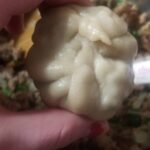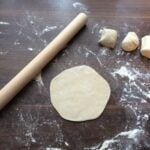Today I’m going to show you how to make extra-large dumpling wrappers big enough to make king-sized Korean dumplings. Korean dumplings are called mandu and these wrappers are called mandu-pi. Ever since I posted my first mandu recipe in 2008 many people who don’t have access to a Korean grocery store have asked me how to make the wrappers at home. It lead me to develop this recipe, which took me some time to perfect.
From experimentation I learned that homemade mandu-pi are a lot tastier than mandu-pi from the grocery store. They are big noodles used to wrap around fillings, so taking time and care to get them right will make your dumplings that much better.
Not only that, but they are easy to make!
This recipe makes king-sized wrappers (or skins), but you could also use this recipe to make smaller wrappers, too. Just divide them into smaller pieces before you roll them out.
Enjoy my recipe, and I hope you make some nice delicious mandu-pi from it. Let me know how your mandu turn out!
Ingredients
(makes 16 large wrappers, each one 5½ to 6 inches in diameter)
- 2 cups all purpose flour plus ¼ cup extra for dusting
- ½ teaspoon kosher salt
- ⅔ cup water
Directions
- Combine 2 cups of flour, kosher salt, and water in a large mixing bowl. Mix with a wooden spoon until it turns into a lump. Then knead it by hand for a few minutes until the dough gets a little softer. Put it in a plastic bag to keep it from the air and let it sit for 10 to 30 minutes on the kitchen counter.



- Take the dough out of the plastic bag. It will be a little softer and moist and easier to handle. Knead it for 5 to 7 minutes, until it’s smooth and elastic.

- Place the dough on a cutting board dusted with a bit of flour and divide it into 2 equal pieces. Put one half into the plastic bag to keep it from getting dried out as your work on the other half.
- Cut the piece of dough into 8 equal sized pieces. Roll each piece out with a rolling pin into 5½ to 6 inch round circle disks. They should be a little thinner on the edges than in the middle, because we’ll eventually be pinching the edges together when we make mandu, so you don’t want them too thick and doughy.



- Take the second half out of the bag and make mandu wrappers out of it using the same method.
- Use them right away to make mandu, or freeze them for later.
To freeze:
- Cover a large platter with plastic wrap and put the wrappers on it. Place them so they don’t touch each other, and separate layers of skins with sheets of plastic wrap.
- When it’s full of skins, cover the entire tray with plastic wrap and freeze it for up to 1 month.

How to use frozen mandupi:
- Thaw out at room temperature for 10 to 20 minutes before using them to make mandu.
Maangchi's Amazon picks for this recipe
It's always best to buy Korean items at your local Korean grocery store, but I know that's not always possible so I chose these products on Amazon that are good quality. See more about how these items were chosen.









































Would it be ok to use a pasta machine to roll out the dough, then cut out circles?
Can we use wheat flour to prepare dumpling wrappers?
I use 1/4 whole wheat flour when I make mine, to make it a tiny bit healthier. I have found this works. I think more than this could start to become a problem, though. It would change the texture.
When you use whole wheat, you also need to add about 1tbsp of water, and let it sit out for longer in the plastic bag. I usually let mine sit for a full 30 minutes. Whole wheat takes longer to soften up and soak up the moisture.
To clarify, I mean 1/4 of your flour can be whole wheat. I usually double this recipe because I have a big family—four kids, plus my husband and me! So that means I use 4 cups of flour, with 1 cup being whole wheat, and then I use 2 tbsp of extra water.
Hi! I’m so happy to have found your amazing recipes. I was hoping to make mandu for my son who has many food allergies. He cannot have wheat or eggs (or sesame), do you have any advice on how to make mandu-pi and mandu without these ingredients? I want him to enjoy the foods I grew up on, your help would be very appreciated ☺️
Hi Maangchi,
Look what I found in my local supermarket today! A Mandu Maker! Certainly gonna be helpful to a non professional cook like me, saving me lots of time.
It´s a set of 5 each, from 2 1/4 inch (5.5 cm) up to 6 inch (15.5 cm), so you can even make king size Mandu with it. I´ll soon be making Mandu again, which is one of my favorites. Then I´ll let you know how it works for me, including a pic or two.
See full size image
And this is how it works:
See full size image
It looks good! Whatever method you use, just wrap the filling and cook! That’s mandu! : )
Mi first try at Mandu-Pi. First fresh ones I used for Mandu in chicken broth: turned out fine. Next day I made fried Mandu. The dough had become sticky and very elastic in the fridge over night, but it worked well enough with some skill, and dusting them with flour, and sticking the edges together with egg white. So I definitely used the wrong flour. Tasted delicious though, with some Dakgangjeom sauce.
For giving them the nice round shape, I used a 4 3/4 inch (12 cm) small bowl, cutting the edges of protruding dough off with a knife. So they became a little bigger than the regular ones, allowing to put in some more filling, but still smaller than the king size Pi. And with all that flour, I´m definitely gonna need an apron… ;)
See full size image
Hi Maangchi, it’s me – again! I want to make some gluten-free dumplings for a friend who is celiac, so I guess I can use glutinous rice flour, yes? I would mix it with a little potato starch. I guess they would definitely change flavour and texture; maybe using this kind of dough, they’re called something else completely! will using the glutinous rice flour and cornstarch be enough, or should I add another (gluten-free) medium? Do you already have such a recipe?
You’re such a wonderful lady; so patient with those of us who ask and ask and ask so many questions, over and over again!
Thank you for everything you do for us, and have done for so long!
Ive made the Mandu-pi
See full size image
Good Day,
I am Valeria and I have a doubt.
Fist of all, I live in Mexico City.
Second, I tried to look for the “all purpose flour”, but I couldn’t find it, instead, I tried it with “wheat flour” and, at the begining, it looked similar, but when I cooked it, it didn’t looked like yours, it was like bread.
Can you please help me to know what kind of flour I have to use?
Hola Valeria, soy de Argentina y yo uso la harina 0000, que es la que se conoce como harina para todo propósito. Espero que te ayude. (La hemos probado en todo tipo de recetas coreanas que llevan all purpose flour y nos salen bien)
Hi Maangchi,
Thanks for this easy dumpling skin recipe. I just love them. It is very easy to make and wrap. I used my own filling recipe which made it so delicious Hope to see more recipes coming up from you. Cheers
Hi Maangchi,
I love your channel and have tried out a few recipes from your website.
I’d like to ask a couple of questions about this Mandu recipe. I tried all purpose flour but the dough shrinked back when i rolled and also the mandu after cook is a bit hard though its skin is not too thick. Would you please let me know what the reasons are so I can make them better next time?
Thanks Maangchi
Hi Maangch, I tried to made Mandu wrapper today, unfortunately when i roll out the dough, it shrink back. is it because i did not knead long enough? please respond back to me. Thanks
It usually happens when you use bread flour instead of all purpose flour. If you used all purpose flour, just roll it out with patience.
Wow wow Maangchi! Just made them and it was a total success!
See full size image
I have seen similar recipes but they all say to use hot water. Is this really necessary?
Oh my~~~!
This was so difficult! I need to go to the gym and build up some muscles before I can knead properly.
My dough turned out a bit though, I’m guessing it’s because I didn’t knead enough. Also it expanded a lot. So my stuffing turned out really small in comparison to the size of the dough after I cook it.
The dumplings I put in my soup were at least 12-13 cm long after taking in the water (and they all open of course).
I am blessed with Korean stores close by… I think I’ll be buying the dough from now on ^^;
Hello, im from Croatia and whenever I get the chance I make Korean food for my family. And I’m only 15 yo.. I love your recipes Mangchi! Thank you!!
Hi Maangchi,
How long do these last in the freezer?
Thank you!
You can freeze the wrappers up to 3 months but be sure to wrap them with plastic wrap or bags so that they don’t stick to each other and dry out.
Hello Maangchi !
I want to thank you for getting back to me within minutes , a few weeks ago when I asked if the dumpling dough could be used for eggroll wraps . My egg roll wraps turned out Absolutely Wonderful ! I did make the dough in my food processor which worked fast and easy , Yeah ! I had a plan in place to use my new Marcato Atlas 150 , pasta maker to roll out the dough into sheets then into square wraps . My goodness this worked great ! I dusted each wrap while making , with corn starch so that they wouldn’t stick to each other . As I was making the egg rolls , I flash freezed them on a greased sheet pan then just bag them up for storage. I don’t deep fry them just because I don’t care for the grease smell in the house so I rub a little olive oil on them and bake at 425 for 30 minutes. I did also cooked them like you do the King Mandu , which turn out excellent as well . Thank you so very much for sharing your wonderful dumpling wrap recipe ! Bye !
Thank you for updating your mandupi making!
“.. I rub a little olive oil on them and bake at 425 for 30 minutes.” That’s a brilliant idea!
Hi Maangchi !
I absolutely love your recipes and you are so fun to watch . Also thank you bunches for your Kimchi recipe ! I am wondering if these dumpling wraps can be used for egg roll wraps? If not do you have a recipe for for egg roll wraps ? Keep the delicious recipes coming , Bye !
Yes, you can use this for egg roll wraps but roll the dough out more thinly.
Hi there!
I would love to try this recipe, but with whole wheat flour. Would you happen to know if it requires a different flour/water ratio when using whole wheat flour?
Can’t wait to try this.
Hi Maangchi!
I just discovered your website last week. I LOVE it! I have been living in South Korea for seven years now and in April I married my wonderful husband here. He’s a Korean guy and we’ve been dating before that for six years. Since being married I’ve been cooking mostly western food. He is not picky and usually likes everything, so I have no stress in the kitchen. I knew how to make 됀정찌계 and 김치찌게, but that was it. Last week I made “galang jim”, “jap chae” and the eggplant side dish. They were so easy to follow when using your recipes!
Tonight I tried to make mandu, and that was not so successful. I must have rolled the mandu skins too much because when I stuffed them, they were very thin. Also, my dough was sticking to my fingers a lot. It did not look like yours in the video. I added more flour but was nervous that I would end up adding too much. I dusted it over the dough also when I used my rolling pin to flatten them. After I made the last skin and filled them, the dough that was made first was really sticking and pulling to the plastic wrap. Most of my mandu has fallen apart. I rolled each one in plastic wrap and will freeze them. I thought I could take the plastic off of them easier if they’re frozen. Is there a way to save them?
Thank you!!!! SO glad I found you. I posted your site on my Facebook page and am telling everyone how great your videos and recipes are!
dear maangchi – this is great! once again you’re amazing! i’ll try this v soon – i can’t wait! you’re a chef queen! :) take care! looks like you’re in NY now not Toronto? when i first became your fan you were in Toronto :) Haeng bokhan chuseok to you & yours!
Thank you +maangchi for sharing this video…have to try this soon…
Hi Maangchi!
Thank you for this recipe! I’m looking forward to your kimchi-mandu!
I do have a bread-maker, that’s ideal for making any kind of dough (and easy to clean).
Regarding the rolling-pin: In Italy, there are similar ones for making pasta.
I made one myself by cutting up a wooden broom-stick.
My buk-che look nearly identical, but I won’t use them – I need them to play the drums! ;o)
Bye, sanne.
haha thank you so much for the story about your homemade rolling pin! Some of my readers have let me know they use a wine bottle. : )